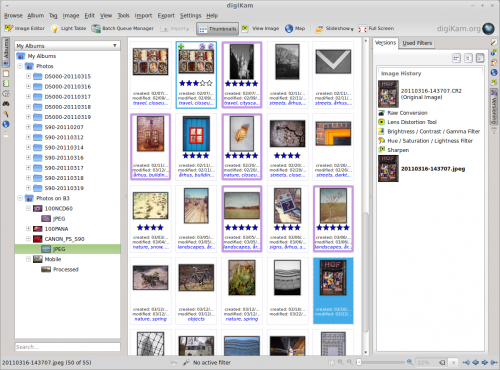Digikam/Versioning/da: Difference between revisions
(Importing a new version from external source) |
(Importing a new version from external source) |
||
| Line 3: | Line 3: | ||
Fra Dmitri Popovs blog, 28. marts 2011 | Fra Dmitri Popovs blog, 28. marts 2011 | ||
Når du justerer fotos i '''digiKam''', så er det nok en god ide at bevare originalerne uændrede. Til dette formål er funktionen ''Versionering'' nyttig. Den lader dig gemme en redigeret udgave af et originalt foto som et separat billede med en liste over alle anvendte handlinger. | |||
The way versioning works is pretty straightforward. When you are ready to save a modified version of a photo, press the <menuchoice>Save As New Version</menuchoice> button. This saves the edited version as a separate image. Keep in mind that if you are working with a RAW file, all versions will be automatically converted to one of the supported graphics formats. By default, it’s JPEG, but you can switch to another supported format. To do this, choose <menuchoice>Settings -> Configure digiKam</menuchoice>, switch to the <menuchoice>Editing Images</menuchoice> section, and select the desired format from the <menuchoice>Save files as</menuchoice> drop-down list. To bypass the global settings, you can save a single version in a different format by clicking on the triangle and choosing the desired format from the <menuchoice>Save in Format</menuchoice> menu. | The way versioning works is pretty straightforward. When you are ready to save a modified version of a photo, press the <menuchoice>Save As New Version</menuchoice> button. This saves the edited version as a separate image. Keep in mind that if you are working with a RAW file, all versions will be automatically converted to one of the supported graphics formats. By default, it’s JPEG, but you can switch to another supported format. To do this, choose <menuchoice>Settings -> Configure digiKam</menuchoice>, switch to the <menuchoice>Editing Images</menuchoice> section, and select the desired format from the <menuchoice>Save files as</menuchoice> drop-down list. To bypass the global settings, you can save a single version in a different format by clicking on the triangle and choosing the desired format from the <menuchoice>Save in Format</menuchoice> menu. | ||
Revision as of 10:05, 1 April 2011
Versionering i digiKam 2
Fra Dmitri Popovs blog, 28. marts 2011
Når du justerer fotos i digiKam, så er det nok en god ide at bevare originalerne uændrede. Til dette formål er funktionen Versionering nyttig. Den lader dig gemme en redigeret udgave af et originalt foto som et separat billede med en liste over alle anvendte handlinger.
The way versioning works is pretty straightforward. When you are ready to save a modified version of a photo, press the button. This saves the edited version as a separate image. Keep in mind that if you are working with a RAW file, all versions will be automatically converted to one of the supported graphics formats. By default, it’s JPEG, but you can switch to another supported format. To do this, choose , switch to the section, and select the desired format from the drop-down list. To bypass the global settings, you can save a single version in a different format by clicking on the triangle and choosing the desired format from the menu.
By default, each version is automatically saved in the same album as the original, so you can end up with multiple thumbnails of the same photo in the album. But digiKam provides an elegant solution to the problem: you can combine the original and all its versions into a single group. To do this, select the original and its versions, right-click on the selection and choose the command. This combines all the selected photos as one neat bundle, and an icon in the lower-right corner of the thumbnail displays the number of images in the group. Alternatively, you can save the version in a separate album: click on the triangle next to the button, select the command, and pick the destination folder.

To view all versions of a photo, select the original in its album, and expand the right . You should then see all versions of the selected photo with a complete list of editing actions.
